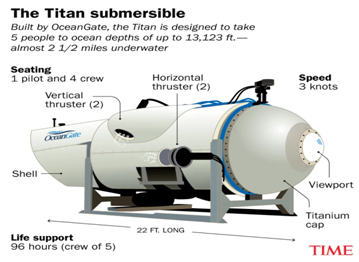Submersible vs submarine: Tourist submersible missing
Why in News?
- The Titan, the vessel that went missing in the area of the Titanic wreck in the North Atlantic, is classified as a submersible, not a submarine.
- Numerous complications – weather conditions, the lack of light at night, the state of the sea and water temperature, depth (14000 feet) – could hinder the effort to rescue the five people aboard the deep-diving submersible.
What’s in Today’s Article?
- What are Submersibles?
- The Titan
- How are Submersibles different from Submarines?
What are Submersibles?
- Submersibles are small, limited range watercrafts designed for a set mission, that are built with characteristics that allow them to operate in a specific environment
- These vessels are typically able to be fully submerged into water and cruise using their own power supply and air renewal system.
- While some submersibles are remotely-operated and essentially manually controlled or programmed robots, these usually operate unmanned.
- Vessels like the missing Titan are known as human-occupied vehicles.
The Titan:
- It was designed to transport five people to depths of around 4,000m in order to reach the Titanic shipwreck, which lies approximately 370 miles south of Newfoundland, Canada.
- Made of titanium and carbon fiber, it weighs around 10,432 kgs and can also take on speeds of about 3 knots/5.5 km per hour.
- It doesn’t have a lot of propulsion so it can’t sail great distances but it has just enough propulsion to sail and operate in and around the wreck and then come back to the surface.
- Experts believe that the Titan likely lost power or communication with its mother ship, the Polar Prince.
- In this case, the Titan’s safety mechanism would activate, causing the ship to release the weight that it had been using to descend to the shipwreck.
How are Submersibles different from Submarines?
- The primary difference between a submersible and a submarine is that the former is launched from a mother vessel, or home vessel.
- Submersibles are typically launched on a raft or platform which is placed into water and ultimately descends down via four electric thrusters which help it to reach speeds of 3 knots.
- When it returns to the surface, it must be loaded back onto the surface platform.
- Submersibles don’t have things like typically large propulsion systems, they don’t have ballast systems. They also have limited power reserves.
- Unlike submarines, submersibles also have a viewport and external cameras to view the outside space surrounding the vessel
